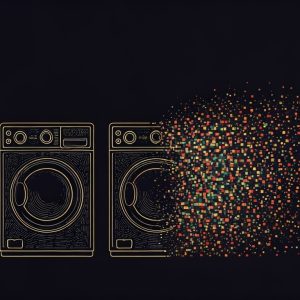Last summer we bought three mobile phones and signed up with two cellular phone services. All the cellular phones were made by Motorola. The first phone, a US model, died within a week. The phone dealer replaced it. No problem. The second phone, a British model bought in London, also lasted a week. A Motorola repair center replaced it on the spot. The third phone, another US model, lasted three months. Enough! We traded the third phone in for a Nokia sold under the name Technophone. It’s just like a real Nokia except it’s plain looking. In New York, the modern Finnish Steal-Me-I’m-A-Nokia design is a liability. In New York you want a Mercedes that looks like a rusty Yugo. We gave away the British Motorola and bought an Ericsson that is a third smaller but runs twice as long as the Motorola on a tiny battery. We traded in the other US Motorola on another Nokia Technophone. The Nokia, like the Ericsson, has twice the battery life of a Motorola. We weren’t surprised when Motorola reported a disappointing quarter it said was the result of problems in its US cellular phone business. Both Nokia and Ericsson say they can’t keep up with demand for their phones. Although Motorola is the leader in the US cellular phone market – or at least it was last year – in Europe Nokia is number one, Motorola is number two and Ericsson is number three. We would be surprised if Ericsson did not rise to second place, right behind Nokia, this year. Nor would we be shocked if Motorola slipped in its home market with the help of AT&T. In New York, our phone dealer is also an agent for AT&T Wireless, nee Cellular One. Used to be, if you signed up for digital cellular service the best deal included a Motorola phone. Now it includes a designer Nokia, a Nokia Technophone or a Nokia AT&T with the death star logo.
Been liberated
At the low end of the market, the dealer still seems to be pushing Motorola analogue phones but the same hardware is probably cheaper at the big electronics discounters who throw in a free phone if you sign up to be overcharged by either AT&T or Nynex. The phones are not really free. The carriers pay the dealers three or four hundred bucks for each new account they bring in on a one-year contract. Then the typical customer pays 40 to 65 cents a minute for airtime on every call, including otherwise toll-free calls, whether incoming or outgoing. On the AT&T net you are considered local for outgoing calls anywhere in the Boswash megalopolis, which is the region in the American northeast where you are most likely to want to dial 911 to report that your pocket phone or car phone, very possibly including your pocket or your car, has been liberated. In London, our One-2-One cellular service has a base charge of #15 a month. Incoming calls are free. Toll-free calls are really toll free. Outgoing local calls are free nights and weekends and calls outside a local area spanning greater London run 10p a minute. Outgoing calls made during business hours are 25p a minute whether local or elsewhere in the UK. The US phone has a serial number in its circuitry that is tied to your account. Your personal phone book is in the phone. You can’t buy or sell the phone without going through some rigmarole with AT&T, even though you have in fact paid plenty for the hardware. By contrast, the UK phone takes a smart card that holds your account information and phone. If your battery poops out and you want to use somebody else’s phone, just insert the smart card and it’s yours. If you want to sell a phone, it’s yours, just do it. When you buy a new phone, it’s on the air for you when you pop in the smart card. If the US cellular phone market is opened up to more than two carriers in any given area, rates will crash and the fat at AT&T Wireless will be treated to financial liposuction. That is precisely what is about to happen in Washington, DC, where a third cellular carrier has gone on the air using a cellular system that is based on technology more closely akin to that of the UK system than to the older US cellular phone schemes. >>Nq
By Hesh Wiener
AT&T is going to fight Personal Communications Services because it paid so much money to Craig McCaw for Cellular One it may never dig itself out. Even now, it’s under so much strain that service features it promised in last year’s sales literature have been deferred. These features are old hat in the UK, so it’s not a technology problem. It may be hard to imagine, but mighty AT&T just can’t afford to meet its promises. As for Motorola, it has been spoiled by the de facto monopoly it enjoyed during the early years of cellular telephone service. The company simply does not understand what the cellular phone customer is thinking, or to be more precise, it does not understand that there are several kinds of cellular customers and the ones who are going to be running up the big phone bills are not happy when their phones die or use up costly batteries in barely 45 minutes of airtime. We are absolutely confident that Motorola tries to build phones that are as strong as rocks and that it holds all kinds of consumer testing sessions in which John and Jane Q Public fool around with mobile phone while being filmed through one-way glass. And that is the shame of it all. Motorola is betting a major part of its business on events occurring in technical and sociological laboratories while it being slaughtered in the marketplace. Our London cellular carrier is stunned by the success of the Ericsson phone it launched for the Christmas season to complement its former best-sellers, which were Motorola instruments. Motorola may be working on a new family of mobile phones with which it could recapture the market lead in Europe. But maybe not. Maybe Motorola is still counting on a vast US market in low-end phones to save its cookies. Well, that’s not going to happen as long as the US carriers charge two, three or four times as much as they would in a more competitive environment. And anyone who can afford a lot of airtime isn’t going to quibble about the extra cost of a Nokia or Ericsson phone designed for more sophisticated customers. High airtime prices are going to put a lid on the US market, or at the very least keep growth to a minimum. And if AT&T or any other cellular carrier thinks it can build customer loyalty with its practices, it is in for a very big surprise. This is the same AT&T that is contemplating an all-wireless super cheap phone network… in England, where British Telecom enjoys the role AT&T plays in the US.
Wagon makers
And England isn’t even the hottest European market for cellular phones. That honor belongs to Sweden. And market growth is faster in France, Italy and Spain and Germany than in the UK. There are considerable parallels between the cellular phone business and the Internet-intranet segment of the computer business. Both are communications based, with content (data) a secondary consideration. Both are aimed at increasing the pace of commerce and other social activity while reducing the cost of higher velocity. In no way will high tech telephony and data communications have an immediate impact on very old alternatives, such as postal systems or batch processing. But in the very long run mobile facsimile and data systems combined with Internet and intranet technologies will have an impact on individual letters similar to that of the landline telephone, but more powerful and pervasive. Established telecommunications hardware makers and service providers may be pioneers in cellular telephony and Internet-intranet technologies, but there is no assurance that they will succeed. They could more resemble the wagon makers and freight companies that succumbed to the telegraph and railroad. It is far too early to consign Motorola and AT&T to the dustbin of economic history, but it is precisely the right time for information processing executives to examine their situation. They should hope that in the lessons of the telecommunications industry will lie some valuable clues to the future of computing, computer makers and suppliers of computer services. From the January
1996 edition of Infoperspectives published by Technology News of America, 110 Greene St, Suite 1101, NY NY 10012, phone 212-3349750 (C) 1996 Technology News of America Co, Inc. All rights reserved.






